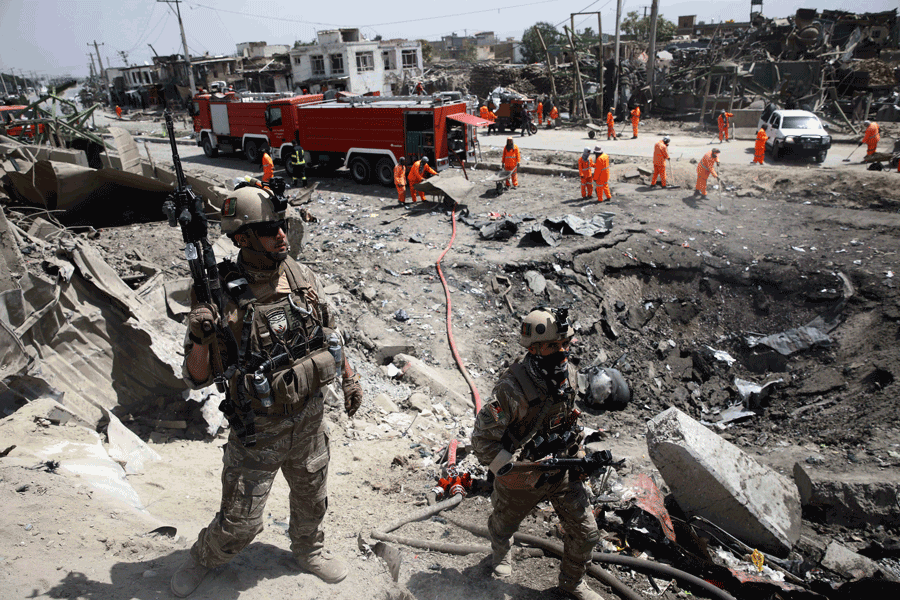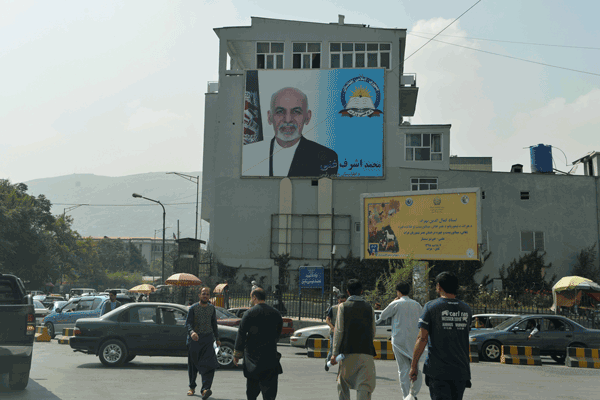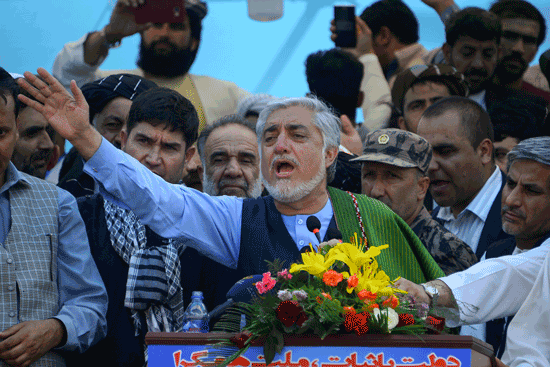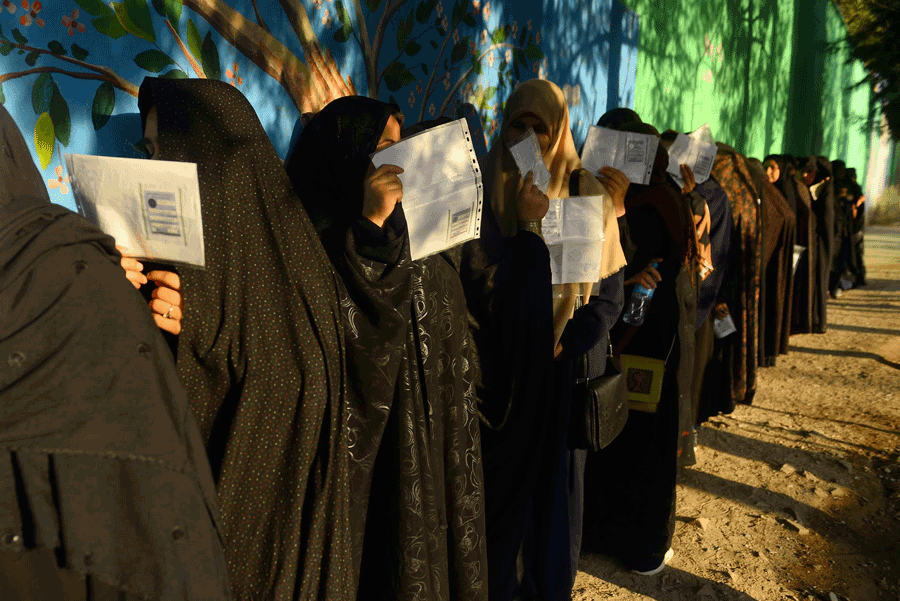War Without End
By Rahimullah Yusufzai | Published 6 years ago
The Taliban and the United States had not stopped fighting during the past 15 months when they were talking to each other in a bid to make a peace deal, but now they have even more reasons to continue their fight.
The breakdown of the peace talks on September 7 following President Donald Trump’s abrupt decision to end the negotiations resulted in intensified fighting. The upsurge in violence was to be expected as the Taliban had refused a ceasefire and pledged to continue fighting until the withdrawal of all the US-led foreign forces. On his part, Trump after increasingly violent attacks by the Taliban, ordered his military commanders to strike hard primarily using airpower, to make the Taliban realise they had miscalculated by undertaking major attacks as the peace talks had entered a decisive stage.

Embattled country: A car bomb targeting the intelligence services building in Qalat before elections.
The Afghan government, the third major party in the Afghan conflict, wasn’t part of the peace talks due to the Taliban refusal to recognise it as an independent entity, but it is certainly involved in the escalation of violence across war-ravaged Afghanistan.
One reason for the Afghan government to deploy 72,000 security personnel and remain proactive at the frontlines was to foil Taliban plans to disrupt the presidential election held on September 28. Security concerns were uppermost in the minds of the voters as they made their decision to vote.
Apart from the repeated Taliban threats to the electorate to stay away from the polling stations to avoid harm, the rampant corruption, bad governance and generally poor performance of the outgoing national unity government of President Ashraf Ghani and Chief Executive Officer Dr Abdullah were factors that mattered when the voters decided if it was worthwhile to cast their ballot. The fact that Ghani and Abdullah were again the main candidates for president, as was the case in 2014, didn’t inspire many voters, as electing one of them meant continuation of the uninspiring status quo. All this led to a low turnout, which would deny the winner the desired mandate needed to talk to the Taliban from a position of strength in the likely event of peace talks between the two sides in the future.

Now that the presidential poll has taken place and the long wait until October 17 for the result is underway, the Americans and the Taliban can reflect on making their next move. The resumption of peace talks in the immediate future appears unlikely, but eventually they would have to return to the negotiation table as continued fighting entails more human and material losses without the prospects of a military victory.
This is painful, considering the fact that the two parties had publicly stated on a number of occasions in the last few months that they had finalised a peace agreement in principle. In the course of those painstaking negotiations that began in July 2018 and started making progress when Afghan-born Zalmay Khalilzad was appointed US special envoy charged with reconciliation in Afghanistan last October, every point was comprehensively argued and finally settled. If there is sincerity of purpose, the negotiations could be resumed where abandoned as the only pending issues now are the new conditions that the US wants to insert in the draft agreement to persuade the Taliban to agree to a ceasefire and give up opposition to direct talks with the Afghan government. In fact, the conditions aren’t exactly new as the chief US negotiator Khalilzad had mentioned them in the past as well. His 13-member team that reportedly included officials from the State Department, Pentagon and CIA was somehow unable to get the Taliban to accept them. Throughout the peace talks, it was obvious that the Taliban on account of their strong position in the battlefield and aggressive posture were able to dictate terms and gain favourable terms in the deal-making.

A continuation of the status quo: Main candidates Abdullah Abdullah and Ashraf Ghani.
Though Trump has declared that the talks with Taliban are dead, he didn’t say they cannot be revived. By saying that he still wanted to withdraw the 14,000 US forces from Afghanistan, he may have kept open the window of opportunity as this has always been the first and foremost Taliban demand. The US negotiating team tried to tempt the Taliban negotiators by offering to pull out their troops in a phased manner so that the Taliban actions could be monitored during the early stages of implementation of the peace settlement. During the negotiations, this temptation worked up to the extent that Taliban agreed not to allow militants with a global agenda the use of Afghanistan’s soil to pose a threat to the US and its allies. It could be used again as the Taliban’s main objective is to ensure withdrawal of the occupying US-led foreign forces after having fought for this goal over the past 18 years. If this is achieved as a result of a peace deal instead of further war, the Taliban would be willing to make a few concessions to make it happen as it would enable them to declare victory.
The Taliban have been more receptive to resumption of the peace negotiations than the US. They even ridiculed the US for adopting an anti-peace stance by cancelling the peace process and said it would lead to a loss of credibility for the only superpower in the world. Though the Taliban pledged to continue fighting ‘jihad’ till the presence of the last foreign soldier in Afghanistan, they also declared readiness for both war and peace and made clear their commitment to negotiations, if this path was chosen by their rivals instead of war.
The fourth Afghan presidential election has inserted a new element in the already uncertain situation in Afghanistan. That the twice-postponed election was finally held despite security concerns was a good omen for Afghanistan’s nascent democracy. Yet another postponement of the election would have raised questions about the future of democracy and the viability of the beleaguered Afghan government due to its inability to hold the polls.
However, the low turnout estimated at 25 per cent has prompted some of the presidential candidates, politicians and analysts to question the legitimacy of the vote and the representative status of the president to be elected in this democratic exercise. Afghanistan’s Independent Election Commission (IEC) said that around 1.1 million voters of the 9.6 million registered to vote had cast their ballots after receiving figures from over half the 4,900 polling stations. The turnout is far below the previous three presidential polls, including the last one in 2014, when seven million of the 12 million registered voters (60 per cent) had voted.
Predictably, the Taliban tried their best to disrupt the election by launching attacks on polling day and also in the run-up to the polls to create fear among the voters.
The Taliban claimed to have undertaken 531 attacks, the Afghanistan Analysts Network put the number at 400 and the Afghan interior ministry downplayed the Taliban threat by insisting that the “enemy” launched just 68 assaults. Four persons were killed and 80 wounded in the attacks.
The 14 presidential candidates, including the frontrunner Ashraf Ghani and his main rival Dr Abdullah, who are presently sharing power in the so-called national unity government, would have to wait unusually long, until October 17, to know the winner. The wait would become longer, until November 7, if the first round fails to produce the winner with 50 per cent of the vote and the second round needs to be staged between the two top candidates. The electoral process could turn ugly if the losing candidates refuse to accept the outcome of the vote or reject the winner’s legitimacy due to the low turnout or rigging. All previous presidential and parliamentary elections were perceived to be rigged and this one too could be challenged and rejected. In that case, the vote would cause more problems than it could solve.

Amid tight security Afghan women voters queue outside a polling station.
This would provide the Taliban the perfect excuse to stiffen their position not to recognise the Afghan president and his government and refuse to engage with it in peace talks. The US alone would be in a position to break the impasse by deciding to resume its negotiations with the Taliban in a bid to make a peace deal and pave the way for movement on an agreed roadmap that would include intra-Afghan dialogue, an eventual ceasefire, exchange of prisoners and amendments in the constitution.
Rahimullah Yusufzai is a Peshawar-based senior journalist who covers events in the NWFP, FATA, Balochistan and Afghanistan. His work appears in the Pakistani and international media. He has also contributed chapters to books on the region.


